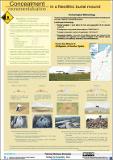Por favor, use este identificador para citar o enlazar a este item:
http://hdl.handle.net/10261/54904COMPARTIR / EXPORTAR:
 SHARE
BASE SHARE
BASE
|
|
| Visualizar otros formatos: MARC | Dublin Core | RDF | ORE | MODS | METS | DIDL | DATACITE | |

| Título: | Concealment-monumentalization in a Neolithic burial mound |
Otros títulos: | Hidding-monumentalization in a Neolithic burial mound | Autor: | Mañana-Borrazás, Patricia CSIC | Palabras clave: | Conceptos Concepts Materialización Materialization Espacio Space Monumentalidad Monumentality Megalitismo Megalithims Análisis estratigráfico Stratigraphic analysis Modelo Organización Organizational Model Neolítico Neolithic NW Península Ibérica Northwest of the Iberian Peninsula Forno dos Mouros 5 Instituto de Ciencias del Patrimonio Institute of Heritage Sciences Patrimonio Cultural Cultural Heritage Incipit |
Fecha de publicación: | 21-ago-2012 | Resumen: | [EN] This poster try to explore the essence of the megalithic phenomenon through one of its most significant elements: the construction of burial mounds. This is a complex phenomenon, with a great variability. A detailed analysis of some monuments allows us to note that we are facing a cultural expression that corresponds to a formal pattern repeated throughout all its existence. The argument is shown through a mound from the NW of Iberian Peninsula. The use of a stratigraphical methodology lets us to identify the Constructive processes and the chronological dating of its different phases, which finally allows to study the variability and regularity of the broader phenomenon. [ES] Este póster trata de explorar la esencia del fenómeno megalítico a través de uno de sus elementos más significantes: la construcción de un enterramiento tumular. Este es un fenómeno complejo, de gran variabilidad. El análisis detallado de algunos monumentos nos permite identificar que estamos ante una expresión cultural que se corresponde a un patrón formal, repetido a lo largo de toda su existencia. Este argumento se muestra a través del análisis de un túmulo del NW de la Península Ibérica. El uso de la metodología estratigráfica nos permite identificar el proceso constructivo y la datación cronológica de las diferentes fases, lo que permite el estudio de la variabilidad y regularidad de un fenómeno mucho más amplio. |
Descripción: | [EN] Poster presented in the poster session in the EAA 2004: 10th annual meeting of the European Association of Archaeologist, September 8th-11th 2004, Lyon, France. Includes the text in English and Spanish that was distributed among the audience at the poster session. [ES] Póster presentado en el congreso de la EAA del 2004: “10th annual meeting of the European Association of Archaeologist” en Lyon, Francia, en la sesión de pósters, entre el 8-11 de septiembre de 2004. Se incluye el texto en Inglés y en Castellano que se repartió en ese momento entre los asistentes a la sesión de pósters. | URI: | http://hdl.handle.net/10261/54904 |
| Aparece en las colecciones: | (INCIPIT) Comunicaciones congresos |
Ficheros en este ítem:
| Fichero | Descripción | Tamaño | Formato | |
|---|---|---|---|---|
| 2004_EAA_Mañana_poster.pdf | Póster | 447,31 kB | Adobe PDF |  Visualizar/Abrir |
| 2004_EAA_Mañana_text.pdf | English version of the text. | 67,23 kB | Adobe PDF |  Visualizar/Abrir |
| 2004_EAA_Mañana_texto.pdf | Versión en castellano del texto. | 63,77 kB | Adobe PDF |  Visualizar/Abrir |
CORE Recommender
Page view(s)
330
checked on 19-abr-2024
Download(s)
234
checked on 19-abr-2024
Google ScholarTM
Check
NOTA: Los ítems de Digital.CSIC están protegidos por copyright, con todos los derechos reservados, a menos que se indique lo contrario.
